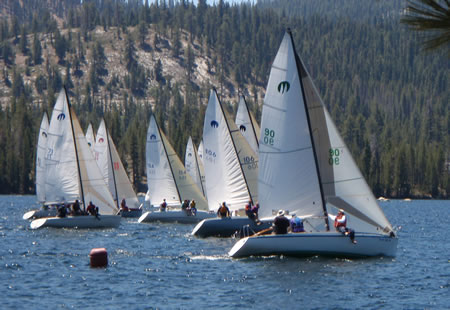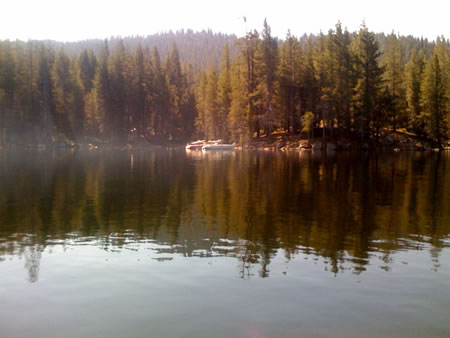Archive for June, 2008
3.14.6 Lifeline Minimum Diameters, Required Materials, Specifications
The reasoning behind a) is that the PVC cracks in the sun allowing water to sit inside the PVC against the wire and eventually it rusts and snaps when the crew are hiking out. This is not only unsafe but it will slow you down and you probably won’t finish the race!
a) All lifelines shall be stranded stainless steel wire of minimum diameter in table 8 below. Lifelines shall be uncoated and used without close-fitting sleeving. Notwithstanding 3.14.6 (a), temporary sleeving may be fitted provided it is regularly removed for inspection
b) Grade 316 stainless wire is recommended.
When using spectra to attach the lifelines I don’t just put the line through the ‘loop’ that is spot welding on the main pulpit/pushpit tube. I figure of 8 the line going through the loop around the pushpit through the loop and back to the eye in the lifeline. That way I am not relying on the spot welding on the pushpit/pulpit.
c) A taut lanyard of synthetic rope may be used to secure lifelines provided the gap it closes does not exceed 100 mm (4 in).
d) All wire, fittings, anchorage points, fixtures and lanyards shall comprise a lifeline enclosure system which has at all points at least the breaking strength of the required lifeline wire.
Table 8
LOA minimum wire diameter
under 8.5 m (28ft) 3 mm (1/8 in)
8.5m – 13 m 4 mm (5/32 in)
over 13 m (43 ft) 5 mm (3/16 in)
4.20.3 Liferaft Packing and Stowage
In Seahorse on the RORC club page the skipper of Holligan V described how difficult it was to access the liferaft when their yacht capsized.
‘Our liferaft was stowed at the stern of the cockpit sole with the knife for cutting the lashing attached to the tiller ahead of the raft – all now underwater and beyond reach. We all carry knives so one of us started to cut through the lashing to release the liferaft. With the stern submerged for muh of the time and at maximum reach for the rest of the time, this proved very difficult and exhausting. It took about half an hour to release the raft and by then the cold was getting to us. Frozen hands dropped the knife just as the last strands were cut through, and we were rapidly losin the ability to think rationally. We finally board the raft but found it impossible to bail with the flexible bailers provided.’
Some key lessons learnt from this experience.
* all crew should carry knives and small waterproof torches as a matter of course.
* liferaft stowage should be reviewed. Ours was accessible with the boat upside down. The four survivors would not be around if our raft had been safely stored in the locker.
Also attaching the liferaft with a hydrostatic release would be a lot safer.
A Liferaft shall be either:-
a) packed in a transportable rigid container or canister and stowed on the
working deck or in the cockpit, or:-
b) packed in a transportable rigid container or canister or in a valise and
stowed in a purpose-built rigid compartment containing liferaft(s) only and
opening into or adjacent to the cockpit or working deck, or through a
transom, provided that:-
i) each compartment is watertight or self-draining (self-draining
compartments will be counted as part of the cockpit volume except
when entirely above working deck level or when draining
independently overboard from a transom stowage – see OSR 3.09) and-
ii) the cover of each compartment is capable of being easily opened under
water pressure, andiii)
the compartment is designed and built to allow a liferaft to be removed
and launched quickly and easily, oriv)
in a yacht with age or series date before 6/01, a liferaft may be packed
in a valise not exceeding 40kg securely stowed below deck adjacent to
a companionway.
c) The end of each liferaft painter should be permanently made fast to a strong
point on board the yacht.
Good thing you are small!

At the weekend I joined another Moore 24 crew for a regatta at Huntington Lake. My normal crew was busy so I decided to go as foredeck with Numa Boa 106. It is a long drive to Huntingon especially when you fight friday traffic out of the city so after getting lost going the locals way we finally got there at around 10pm. The rest of the crew had taken friday off and gone up on thursday with the boat. They had the campsite all set up and a delicous meal of potatoes, corn and steaks ready for us when we arrived. They had even caught some trout from the lake and cooked that up on a roaring campfire.
Stupidly I forgot a flashlight – not sure how I did that – however putting up my tent was not that hard as it is pretty simple and I had thankfully left it packed in a way that made it plug and play. The guys continued to party till 2:45 in the morning I decided to hit the hay around midnight. In the morning I woke to find that we were camping right on the lake shore.
On Saturday we had to put the rudder in the boat and attach our ‘borrowed’ tiller as the boats carbon one had gone missing. We launched the boat and went back to the campsite for breakfast. This is a relaxing regatta with 11:30 starts and short races in beautiful mountain scenery. We had three races on Saturday and our guest sailor was Gilles’s (one of the owners) girlfriend Sally who did a great job slithering under the boom vang. Sailing a Moore with 5 people is squashed. Our first race was not stellar but Mark (other owner) pulled off some great starts and race 2 we got the best result they have had in 8 years of a 3rd finishing overlapped with 2nd and 4th. Dinner on Saturday was chicken which had been marinated all day in orange vitamen water (for that citrus flavour) and soy sauce.

As we left the campsite to go to the bar thinking we would find Moore sailors we were slightly blocked in but Gilles managed to sneak the car through the space to which the women blocking said ‘good thing you are small’ which due to Gilles stature and the whole timing led to peels of laughter from within our car. In fact I have to say the Numa Boa crew is the most caveman like crew I have sailed with in a long time with no pretense at being the least bit refined! The jokes were like preschool full of toliet humor and there was a lot of sticking things up orifices if people didn’t shut up! It became a who can shock Ashley the most I think. However, with Sally and Anne Marie there the girls tried valiently to fight back and clean up the conversation – really to no avail.
Sunday we changed the rig tune a little. Gilles and I decided that both of our boats were examples of the cobblers shoes – with plenty of things needing fixing. Gilles has a business rigging in the bay and he is very good at it. Our other crew was Andy who has been on the Moneypenny program for the last few years and just returned to the Bay. It was a great crew to be sailing with as no one had to be coached. Gilles drove on Sunday and we lined up with the top boats for some speed testing before the start bouying our confidence by staying with both of them straight line. On the first race of the day we were in second place for most of the race getting a great start at the boat (shore) and getting every shift, with great height and speed. Downwind the fleet compressed as the wind came in from the back but we held second till right at the mark rounding when we had to let someone inside as they got an overlap on the last surf. From then on it was a reach then a short downwind then a short upwind. Unfortunately there was a little melt down on the boat due to the over excitement of our unusual position of being so far up in the fleet and we lost 3 boats at the end resulting in a 5th. A shame as a second was accessible for us and very possible. The last race saw the boat leading the regatta retire as they had won without sailing the last race and our first start was very good however the rest of the fleet was general recalled. Unfortunately our start wasn’t great and we played catch up from there. Gilles and Andy were staying Sunday night so lucky Mark and I were able to tie the boat to the dock and get on the road home.
A very enjoyable weekend with some really fun competitive sailing, good food and beautiful scenery.
4.23 Pyrotechnic Signals
In Seahorse RORC Club page pyrotechnics were discussed….
The brightness of white flares varies significantly the best giving off 10K candela and the worst 2.5K. The only way to find out the candela is to check the manufactuere’s data sheet as it is not on the flare container.
During the Holligan V incident a wave dropped into the flare container which promptly sand along with the rest of the flares. A suggestion is to store them in a buoyant container. Also it was noted that flares have different ignition systems which are hard to read in the dark when in the water. The storage of flares needs to be accessible so that in the case of a capsize they are very easy to find.
|
red |
red |
white |
orange |
race |
|
6 |
4 |
4 |
2 |
MoMu0,1 |
|
4 |
4 |
4 |
2 |
MoMu2,3 |
|
|
4 |
4 |
2 |
Mo4 |
|
2 |
4 |
4 |
2 |
Mu4 |
TABLE 13
*Specifications
of white flares (except colour and candela rating)
should comply with the LSA Code Chapter III 3.2

